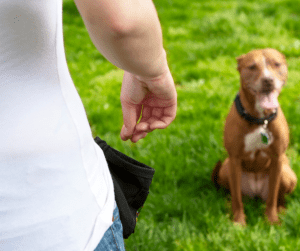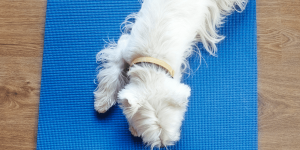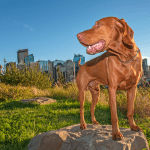Teaching Your Dog – ‘Place’ or ‘Settle on the Mat’.
In this Holidays4Dogs training article we will guide you through the steps of how to teach your dog to go to his mat, or bed. Teaching your dog to do this is will benefit you (and your dog) in all sorts of different situations. Read on to find out how to teach your dog to settle.
Teaching your dog to settle on a mat can be useful in many different settings and locations. It can help your dog to stay calm when visitors arrive. It is also helpful when eating out at a pub or café and, of course, during vet visits or grooming sessions. In addition, teaching your dog to settle quietly away from you can help your dog to be less clingy and more confident.
Ideally, you want your dog’s mat to be something portable which is easily moved around the house or other locations. The mat should be reserved for ‘place’ training only, rather than a bed that stays in place permanently. Your dog needs to associate the mat with settling and, importantly, staying there until released.
Clicker training.
Clicker training is idea for teaching this task, but you can also use a verbal word instead, such as “good”.
TIP: Some dogs that have been previously clicker trained for high energy skills, like heelwork for example, may become too excited. As the aim is for the dog to learn to be calm rather than learning a particular skill on the move, using a quieter verbal marker may work more effectively.
To find out more about clicker training and how to get started, see our other Holidays4Dogs article. It would be helpful if your dog already knows what ‘down’ means. If he is not familiar with this command, teach it separately without the mat.
The next thing you need is lots of treats! If possible have some medium and some high value treats. This might be a combination of proprietary dog treats as well as cheese, or cooked liver and chicken.
Start the training in a quiet part of the house where there are no distractions. There are several ways of achieving the settle using positive training; capturing, targeting, luring or shaping. In this instance, we will explain luring as an easy method for the novice.
Teach your dog to settle – The method.
Luring is probably a bit quicker if you want to get going, so this is the method we will describe.
Show your dog a treat and lure him onto the mat, as soon as he steps onto the mat – give him a high value treat.
Once he’s on the mat you can then ask him to move off it by walking away, so that he follows you.
Repeat this over several repetitions until you see that your dog begins to move towards the mat by himself – in anticipation of the treat.
You can then begin to ask for a down. This stage may take a little longer since you are asking him now to carry out two commands – to go out to the mat and lie down before he gets his treat. As soon as he lies down, praise (click) and treat. Repeat, repeat, repeat!
If he will lie down on cue, wait until he is in the down position on the mat, before giving him the treat.
Once he is in the down, again invite him off the mat and repeat.
Gradually, build the time up between your dog lying down and giving him a treat. Make sure your dog is calm when you reward him.
Avoid rewarding him for moving around, wriggling, whining etc. You are aiming to mark – with the click, or verbal word – for calm behaviour when on the mat – as well as rewarding him for staying there.
Next steps.
The next step is to increase the amount of time he must stay lying down on his mat. Once he is going to the mat and lying down straight away, wait a few seconds before you give him a treat. Build this time up gradually. If your dog gets up, quietly ask him to go back to his place and start again from the point where your dog was last doing well.
 You will also need to gradually move further away from your dog. Ideally, it will be most useful if you can leave your dog on his mat while you answer the door, or attend to visitors, for example.
You will also need to gradually move further away from your dog. Ideally, it will be most useful if you can leave your dog on his mat while you answer the door, or attend to visitors, for example.
Gradually increase the distance you can move away from your dog before rewarding him. Leave the room for a few seconds, return and reward.
Leave the room for longer and longer periods, before returning and praising. If your dog fails, simply go back a few steps in the training programme.
You can also practice moving his mat to different places in the house. Some dogs will catch onto this quickly, but because dogs don’t usually generalise, others will need to begin all over again in a different room. Progress, however, should be speedier.
In addition, you can do away with the mat, by folding it to make it smaller and smaller, until eventually you can dispense with it altogether. You can then send your dog in a specific direction and ask your dog to ‘down’ on the spot you want him to stay on.
Tips.
Intersperse your high value treats, for medium value ones – give him the high value treat for really good moves onto the mat, or for a good, calm stay.
Don’t be overly excited when you deliver the treats, just place them calmly on the mat, or between his feet if he is lying down.
It will help if you can sit on the floor with him when you start the training.
As you build the steps up you can begin to add in a cue – “go to mat” or “settle” etc as well as a release cue such as “free” or “o.k.” when you have finished the exercise.
This may take several days or even weeks of practice, a few minutes a day. Don’t try to push the training forward too quickly. When you teach your dog to settle, take your time.
Final steps.
The next stage is to add distractions. So, you could begin by turning your back, clapping your hands, or asking your dog to go to his mat while the cat runs by! The final stage is to take the mat to other locations, but begin in quiet places first.
If you move straight to a busy pub for instance, your dog may not be successful! Try a quiet spot in the park, a friends house, (not busy), or even the pet shop on a quiet day. Soon you will find your pooch will be perfectly happy to settle calmly on his mat, at times when you need him to.
For other training exercises you can read more here and here.



